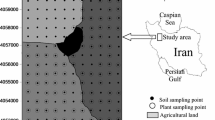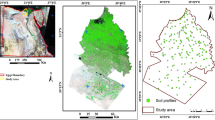Abstract
The aims of this study are: (1) to produce a geometrically corrected physiographic–soil map scale 1:50,000 reduced to the attached map scale 1:300,000 for the studied area as a base to survey the heavy metals content and (2) to check the sustainability of the agricultural ecosystem through checking for the possible consequences of using drainage water as a source of irrigation water in some areas in El-Fayoum depression which have high heavy metal content due to pollution effects. To fulfill the first aim, 16 soil profiles were chosen to represent the different mapping units. Morphological description was carried out, and soil samples were collected for physical and chemical analysis. Based on enhanced thematic mapper images analysis and the geographic information system, coupled with the field work and laboratory analysis data, the physiographic–soil map was produced. The following main landscape units can be identified: (1) alluvial plain, (2) fluvio-lacustrine plain, and (3) lacustrine plain. With respect to the second aim, the drainage water dissolved heavy metal analysis was determined. The analysis shows that using this water as the sole source of irrigation in some areas in El-Fayoum depression, which is actually the case, with a cadmium dissolved content of 0.02 ppm will lead to an incremental increase of 80 g cadmium per acre per year, and since the warning value for cadmium concentration in the surface layer of the soil is 5 μg/kg, i.e., 5 kg/acre. The warning value amount will accumulate in the soil during a period of 66 years. So, there are very strong doubts about the sustainability of this system. There are already signs of the buildup of heavy metal accumulation in the surface layer due to the use of drainage water in irrigating some parts of the studied area.














Similar content being viewed by others
References
APHA (1998) In: Clesceri LS, Greenberg AE, Eaton AD (eds) Standard methods for the examination of water and wastewater, 20th edn. American Public Health Association, American Water Works Association, and Water Environment Federation, Washington, DC
Cheng WD, Zhang G, Yao H, Wu W, Xu M (2006) Genotypic and environmental variation in cadmium, chromium, arsenic, nickel, and lead concentrations in rice grains. J Zhejiang Univ Sci B 7:565–571
Dobos E, Norman B, Bruee W, Luca M, Chris J, Erika M (2002) The use of DEM and satellite images for regional scale soil database. In: 17th world congress of soil science (WCSS), 14–21 August 2002, Bangkok, Thailand
Egyptian Metrological Authority (1996) Climatic atlas of Egypt. Ministry of Transport, Cairo
Elberson G, Catalon R (1987) Portable computers in physiographic soil survey Proc. Intern. Soil Sci., Cong. Homburg
FAO (2006) Guidelines for soil description, 4th edn. FAO, Rome
Grant CA, Buckley WT, Bailey LD, Selles F (1998) Cadmium accumulation in crops. Can J Plant Sci 78:1–17
ITT (2009) ITT Corporation ENVI 4.7 software. ITT Corporation, White Plains
Lillesand TM, Kiefer RW (2007) Remote sensing and image interpretation, 5th edn. Wiley, New York, p 820, Paperback September 2007
Lindsay WL, Norvell WA (1978) Development of DTPA soil test for zinc, iron manganese and copper. Soil Sci Soc Amer J 42:421–428
Moen JET, Cornet JP, Evers CWA (1986) In: Assink JW, van den Brink WJ (eds) Contaminated soil. Dordrecht, Martinus Nijhoff
Said R (1993) The River Nile geology and hydrology and utilization. Pergmon, Oxford, p 320
USDA (2002) Field book for describing and sampling soils. National Resources Conservation Service (NRCS), United States Department of Agriculture. September 2002, version 2. USDA, Washington, DC
USDA (2004) Soil survey laboratory methods manual soil survey investigation report no. 42, version 4.0, November 2004. USDA, Washington, DC
USDA (2010) Keys to soil taxonomy. Natural Resources Conservation Service (NRCS), United States Department of Agriculture, 11 edn. USDA, Washington, DC
Author information
Authors and Affiliations
Corresponding author
Rights and permissions
About this article
Cite this article
Abdel Kawy, W.A., Belal, AA. Spatial analysis techniques to survey the heavy metals content of the cultivated land in El-Fayoum depression, Egypt. Arab J Geosci 5, 1247–1258 (2012). https://doi.org/10.1007/s12517-011-0312-9
Received:
Accepted:
Published:
Issue Date:
DOI: https://doi.org/10.1007/s12517-011-0312-9




